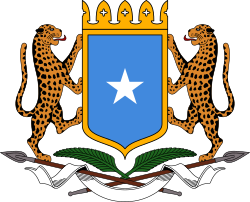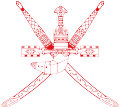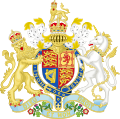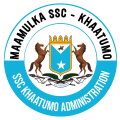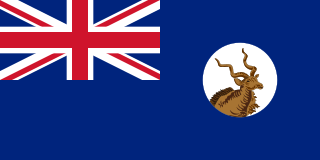
British Somaliland, officially the Somaliland Protectorate, was a protectorate of the United Kingdom in modern Somaliland. During its existence, the territory was bordered by Italian Somalia, French Somali Coast and Abyssinia. From 1940 to 1941, it was occupied by the Italians and was part of Italian East Africa.

The national flag of Egypt is a tricolour consisting of the three equal horizontal red, white, and black bands of the Egyptian revolutionary flag that dates back to the 1952 Egyptian Revolution. The flag bears Egypt's national emblem, the Egyptian eagle of Saladin, centred in the white band.

The flag of Somalia, also known as the Somali flag, was adopted on October 12, 1954, and was designed by Mohammed Awale Liban. The flag was initially used within the Trust Territory of Somaliland before being adopted by the short-lived State of Somaliland and the Somali Republic. It is an ethnic flag for the Somali people; the flag's five-pointed star represents the five regions in which Somalis reside.

The coat of arms of Germany displays a black eagle with a red beak, a red tongue and red feet on a golden field, which is blazoned: Or, an eagle displayed sable beaked langued and membered gules. This is the Bundesadler, formerly known as Reichsadler. It is one of the oldest coats of arms in the world, and today the oldest national symbol used in Europe.
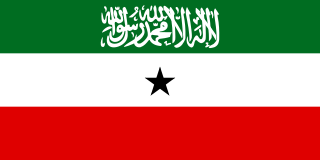
The flag of Somaliland was adopted on 14 October 1996. It consists of a tricolour of green, white, and red, with a black star located in the centre. On the green stripe, there is the Shahada in white calligraphic script.

The national emblem of Indonesia is called Garuda Pancasila. The main part is the Garuda with a heraldic shield on its chest and a scroll gripped by its legs. The shield's five emblems represent Pancasila, the five principles of Indonesia's national ideology. The Garuda claws gripping a white ribbon scroll inscribed with the national motto Bhinneka Tunggal Ika written in black text, which can be loosely translated as "Unity in Diversity". Garuda Pancasila was designed by Sultan Hamid II from Pontianak, supervised by Sukarno, and was adopted as the national emblem on 11 February 1950.

The emblem of the Italian Republic was formally adopted by the newly formed Italian Republic on 5 May 1948. Although often referred to as a coat of arms, it is an emblem as it was not designed to conform to traditional heraldic rules. The emblem is used extensively by the Italian government.

Since 2011, Libya currently does not have an official national emblem. The Constitutional Declaration issued by the National Transitional Council on August 2011 defines the flag of Libya, but does not make any provisions for a coat of arms.

A colonial empire is a collective of territories, either contiguous with the imperial center or located overseas, settled by the population of a certain state and governed by that state.

The national emblem of Djibouti was introduced after attaining independence from France on 27 June 1977. It was made by Hassan Robleh. It is bordered on the sides with laurel branches. Within this perimeter there is a vertical spear, in front of which is a shield. Underneath the shield, two hands rise away from the spear, both of which carry a large machete. These two hands symbolize the two main indigenous ethnic groups that make up the Djiboutian people: the Afars and the Issas, and they have roots in Ethiopia and Somalia. The spear is topped by a red star. The star symbolizes the unity between the Issa and the Afar peoples. A Djibouti law established the seal and states its significance, and has been translated into English.

The lion is a common charge in heraldry. It traditionally symbolises courage, nobility, royalty, strength, stateliness and valour, because historically the lion has been regarded as the "king of beasts". The lion also carries Judeo-Christian symbolism. The Lion of Judah stands in the coat of arms of Jerusalem. Similar-looking lions can be found elsewhere, such as in the coat of arms of the Swedish royal House of Bjelbo, from there in turn derived into the coat of arms of Finland, formerly belonging to Sweden.

A naval ensign is an ensign used by naval ships of various countries to denote their nationality. It can be the same or different from a country's civil ensign or state ensign.

The national emblem of Somaliland, was introduced on 14 October 1996 along with the flag of Somaliland, when it was approved by the National Conference. It was introduced by Abdullahi Abdi Omar (Jawaan).

Dubat ; Arabic:العمائم البيضاء ); ḍubbāṭ: English: White turban) was the designation given to members of the semi-regular armed bands employed by the Italian "Royal Corps of Colonial Troops" in Italian Somaliland from 1924 to 1941. The word dubat was derived from a Somali phrase meaning "white turban".

The Serbian eagle is a double-headed heraldic eagle, also known as the White eagle, a common symbol in the history of Serbian heraldry and vexillology. The double-headed eagle and the Serbian cross are the main heraldic symbols which represent the national identity of the Serbian people across the centuries, originating from the medieval Nemanjić dynasty. The eagle, defaced with the cross, has been used in the coat of arms of the Kingdom of Serbia from 1882 to 1918 and in contemporary coat of arms of the Republic of Serbia since 2004.

The national emblem of Eritrea was adopted on 24 May 1993 on the occasion of Eritrea's declaration of independence from Ethiopia. The emblem mainly depicts a camel surrounded by an olive wreath.
During its modern history, various national symbols have come to represent Somalia. Due to the country's instability, many of these are only used in areas under the Federal Government of Somalia, and may not apply to breakaway regions such as Somaliland.
This article presents the coats of arms of Italy.
